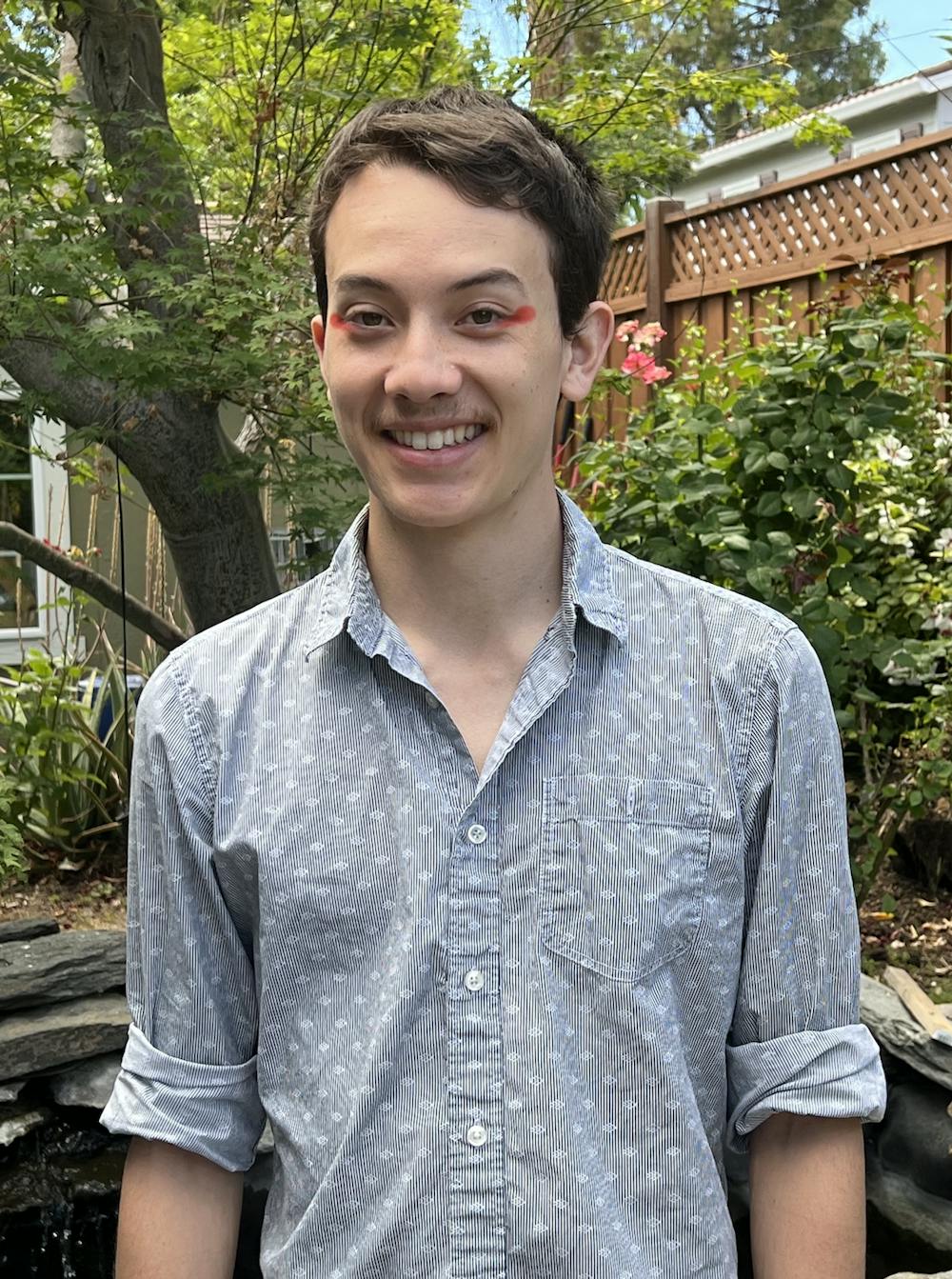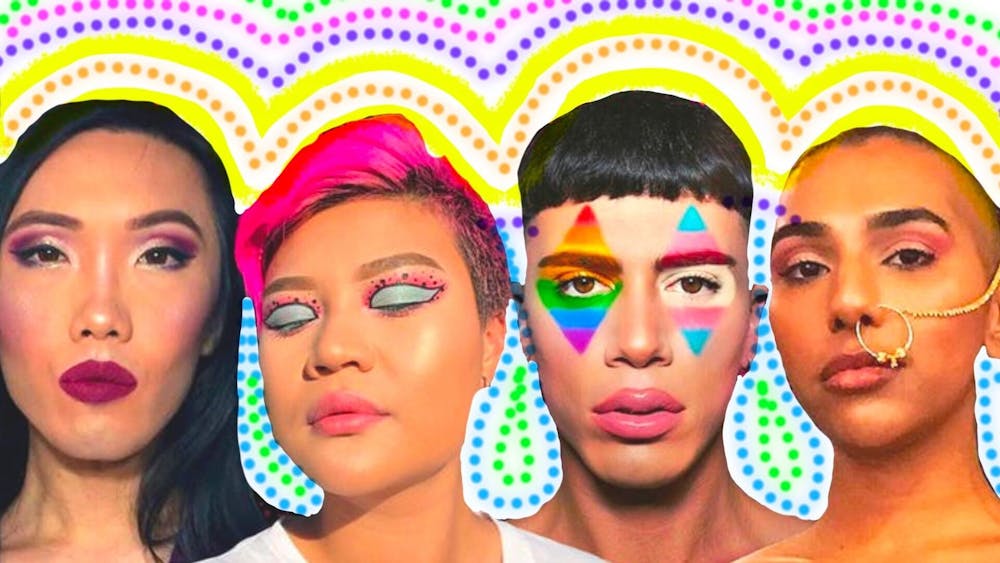Aesthetics have always been a part of LGBTQ identity. Whether it be through clothing, hairstyle, or pastel hair dye, fashion choices can serve as visual symbols of queerness.
Cianán Conefrey–Shinozaki (E ‘23, C ‘23) takes note any time he sees exciting, visibly queer fashion choices. “You stare at someone who’s queer, and you’re like, ‘I’m not homophobic, I just really like your look.’” They wish they saw people around campus making experimental fashion choices more often.
A large part of queer fashion—and an experimental one, at that—is makeup. Sometimes, depending on its subtlety, makeup is the first thing we notice about another person. It can grab attention, make someone seem approachable (or not), and shape others’ first impressions.
Beyond just style, choosing to wear or not wear makeup can serve as a broader expression of identity due to its status as a heavily gendered product. It can signal a commitment to or refusal of historical masculinity or femininity—or a refusal of gender altogether. For many years in the United States, most women have been expected to wear makeup, and men were shamed if caught wearing it. For all users, though, makeup is typically marketed as a tool to beautify, perfect, and—in the case of “no makeup” makeup looks—erase blemishes. But for many queer makeup artists, the goal is much more affirming and artistic. “I feel like a lot of the makeup I see that is very gendered, from makeup bloggers and such on YouTube … [is] about concealing,” Cianán says. “The queer ethos is very different from that.”
Scrolling down TikTok, you’re met with queer makeup looks that are often colorful, complex, and loud. The boldness is stereotypical of queer fashion, partly due to the prevalence of drag. But it continues now online, with looks ranging from neon eyeliner to near–SFX makeup. These looks are not about concealing or perfecting, but expressing. They’re impossible to ignore, shouting nonconformity across the street or internet.
“Instead of, ‘I want to hide the fact that I have baggy eyes or pimples,’ the bigger emphasis is [often], ‘Look at me, I’m queer. I’m doing crazy things. I don’t subscribe to your idea of gender,’” Cianán explains. “I try to channel that sometimes. I like it a lot.”
Through this lens, makeup is less about fitting into a mold and more about standing out. Even as queer makeup follows trends, it’s still personal. It gives space for anyone to uniquely recreate a look as only they can.
This is how Cianán uses makeup in their life. They defy the gendered conventionality of makeup and the queer stereotype of bright, complicated styles. He also rejects the expectation that all queer makeup must be especially polished and perfected, which might also come from drag’s place in the modern cultural imagination. A friend once told Cianán that they should do their makeup differently to meet this standard. “He [said], ‘It should be very well–done, [with] clean lines. Well–sculpted.’” Instead, Cianán’s daily routine is as minimalist and unsculpted as they come: a dot of red eyeshadow at the corner of each eye.
Some days, the dot is just that: a perfect circle. Others, it’s a dash or an even longer line, stretching out past their eyebrows. Occasionally, the line snakes inward across the bridge of their nose, down across their lower lash line, or curves upward past their brows. It’s always symmetrical, but still just a soft wash of plain red powder and nothing else.
Sometimes, Cianán jokes, confused friends will ask him if he’s been hit, thinking the red powder is a welt. In reality, it’s their identity written across their face—in more ways than one.

Photo Courtesy of Cianán Conefrey–Shinozaki.
For Cianán, makeup is connected to their nonbinary identity. When they first experimented in high school, makeup was unpleasant and hyperfeminine, limiting their range of expression. “I didn’t like how sticky mascara was or how thick foundation was … I didn’t realize you could do these experimental makeup looks in an everyday kind of context.” Realizing that he didn’t have to conform to the gender binary freed Cianán to experiment with his makeup more, creating nontraditional shapes and styles.
“I did a tiny little dab of color on each eye and [said], ‘Okay, that’s good.’ And [my friend] said, ‘You know you can have fun with it. You can just do whatever you want.’ So I drew a stripe across my face. I really liked it. It gave me German EDM night club energy.”
When looking for inspiration to shape his abstract stylings, Cianán bought a book on kumadori, the makeup used in Japanese kabuki theater, and began channeling his Irish–Japanese heritage through his eyeshadow. “I remembered that there’s a long history of Japanese makeup theater, wherein you have these graphic red shapes which I liked, and there are very specific designs that represent emotions and character structures. I really gravitated toward that.”
In aragoto kabuki—the more dramatic style of theater, where kumadori is used—red designates heroes and symbolizes moral goodness. Blue, on the other hand, symbolizes villainy, and brown or green symbolizes the otherworldly. The horizontal lines Cianán draws around their eyes daily are worn to represent a young hero beginning a journey. Cianán’s makeup tells the story of his identity to everyone he meets, even if it is a language only he speaks.
Cianán looks to queer and Asian–American makeup artists online for inspiration, representation, and appreciation. He points to artists like Juno Birch, whose eye–popping alien drag is something he admires but would personally never wear. Following Asian–American artists also serves as a logistical benefit—Cianán appreciates that creators like Justyn Gee and ChristieX design makeup looks with hooded eyelids in mind. With online creators like these, Cianán and others can see their own intersectional identities represented in role models, artists, and the faces wearing art themselves. Queer makeup artists online show their followers that queer hands are capable of creating such beauty and creativity, and that their faces are worthy of wearing it.
Makeup is personal. It’s a personal choice as to if, when, and how to wear it—and that choice comes alongside the knowledge that makeup changes how we are seen. For those who wear it, though, it can be powerful, showing ancestry, gender, sexuality, and fashion all on their face. When it comes to queer makeup artists—whether that means always applying a full face or just the everyday dash of concealer—everyone can come together in pride.

